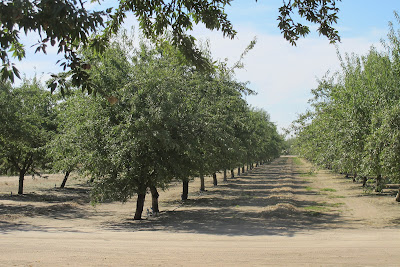 |
 |
| Almonds almost ready for harvest |
The Boersma Brothers have almond trees on 17 ranches/fields in the Ripon/Modesto area. Most are owned by them, but a few are leased. Brent explains that there are 30 varieties of almonds, but they deal in the 10 major ones with such names as Carmel, Butte, Aldrich, and the most common, Nonpareil. The Nonpareil are the ones that most people are used to eating straight out of a can/jar of nuts as they are the most consistent in size, shape, taste.
 |
| Brent Boersma |
I ask about the lifespan of a tree and Brent explains the process for a field. We pass a field that they purchased that used to be peach trees. The peach trees were all pulled out and the field was allowed to go fallow for a year to allow time for the soil to recover some nutrients. New trees are planted with almond buds that have been grafted onto hybrid rootstock, usually peach or plum. They are left to grow for a few years until they can reach their first harvest. This means that for five years this particular field is under water money-wise as it is not generating any income and instead is consuming money as they tend to the trees. The trees will start producing after about three years and reach their peak at about year eight. They will be allowed to grow for about 30 years before the process is repeated with new trees.
 |
| 30 yr old tree |
I found it interesting that the soil around the tree roots is treated with soil fumigant the same as with the strawberries I saw last year at Naturipe. In fact, they used the same methyl bromide until recently since it is now banned worldwide. Just like strawberries, they are caught in the conundrum of what to use now since no satisfactory new fumigant has yet been discovered.
Harvesting isn't just simply shaking the trees and collecting the nuts in a single day. The first step is the shaking of the trees. Brent explains that as recently as 30 years ago it was still done the old fashioned way with climbing ladders and knocking the branches with rubber mallets and letting the nuts fall. Now they have a piece of equipment that drives down the rows, grabs the tree around the trunk, and then shakes the nuts to the ground.
Almond Harvest 2011 - Shaking from brentboersma on Vimeo.
Here in Brent's video you will notice that the machine is not shaking every tree. That's because it is skipping the ones that aren't of the same variety.
The nuts, hulls, leaves, and debris are now strewn all over the ground. This is what I saw on my stop along the road. It turns out that they are actually left like that for a week to dry out. Then a sweeper comes down the row and sweeps/blows the nuts into windrows down the aisles.
 |
| picking up a windrow |
This loader performs a primary sort to pull out any twigs and branches and to sift out a lot of the dirt and rocks. The nuts in their shells and the hulls and leaves get carried up to the truck to be transported to the shelling facility.
Just getting to this point can take a few weeks - shaking, drying a week on the ground, collecting into windrows, scooping up and transporting. Now multiply that out depending on the number of varieties in each grove.
At the shelling center the trucks dump their load into these grates and the nuts start their way through the facility.
This video shows the nuts and hulls (with an occasional twig or rock) going down, then through a series of rollers (not visible) which crack the shells surrounding the nuts, up to the shaker tables that shake out the nut meat from the hulls, leaves, and shells.
The hulls are blown into this huge stack in a covered barn where they wait for an optimal price before selling them to be used as cattle feed, usually to dairies. The hulls have plenty of nutrients in them. The shells do not and don't get much money at all. Still, they are also carted away to be used industrially elsewhere.
I can't help but think that almond farming is a good crop to be raising. Almonds have become essential in all sorts of foods, but also more important in special diets such as gluten-free or paleo. The lesser quality almonds go into almond milk and almond flour. Brent says he's happy with how the almond industry has really done well to market them into all sorts of products and all over the world, as almonds are important to Chinese, Indian, Mideastern, and European dishes.
I want to thank Brent for allowing me to come and visit. It's these sort of visits that I enjoy the most - learning about the lives of farmers, the crops/livestock they raise, and the parts they play in putting food on our plates.
For other Farm-to-Fork style stories like this one, click here: Farm-to-Fork

.png)




